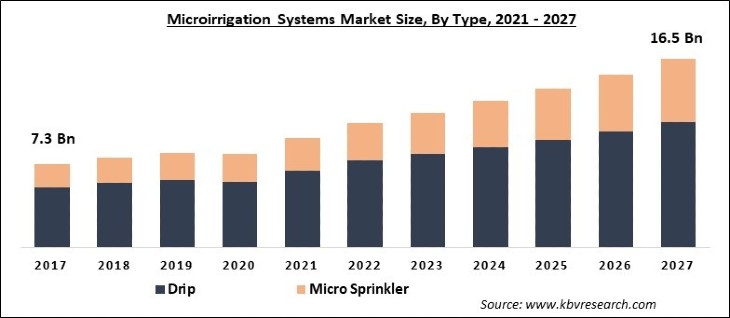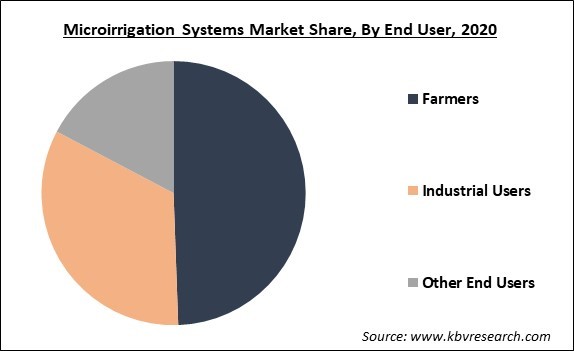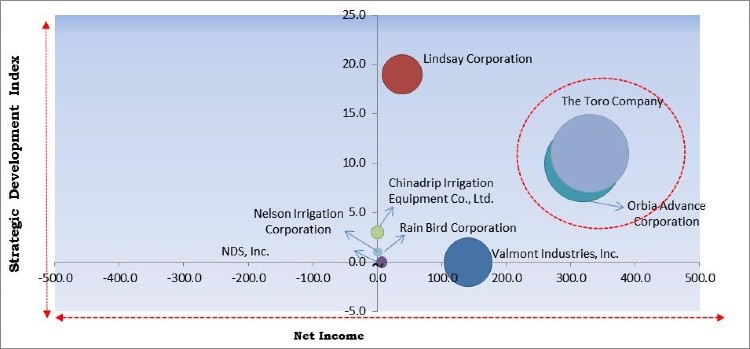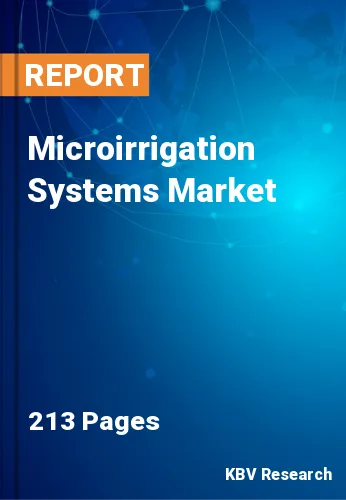The Global Microirrigation Systems Market size is expected to reach $16.5 billion by 2027, rising at a market growth of 9.5% CAGR during the forecast period. Micro-irrigation refers to the irrigation procedure having lower water pressure and flow as compared to the conventional sprinkler system. The primary reason to deploy micro-irrigation systems is water conservation. Various kinds of system parts are installed in micro-irrigation systems.
The majority of these involve sand separators, pre-filters, screen filters, media filters, and disc filters. Moreover, micro-irrigation systems have gained high popularity in the last couple of years due to their water-efficiency and low-cost. Additionally, these systems can slow down the development of unwanted plants (weeds), cost of cultivation and soil erosion.
Micro agricultural systems help to reduce water waste and soil erosion and as a result, the market is expected to see a surge in demand from emerging countries. Small-scale farmers are focusing on using these technologies to boost agricultural yields while using the least amount of water possible. Additionally, growing technology improvements in micro irrigation systems are making it easier for vast land farmers in the agricultural sector and large lawn owners in the residential sector to control and monitor water flow and intake.

The COVID-19 pandemic had a worldwide influence, with grave consequences for various industries. The pandemic's consequences on the water-energy-ecosystem-food nexus are still complex and far-reaching. The irrigation industry, which supports hundreds of millions of agricultural jobs in rural regions, is responsible for the world's key food production systems, the lives of the majority of the poor across the world, and the transition to water-saving sustainable practices. Despite difficult circumstances, drip irrigation firms around the world have continued to operate. However, there have been several shocks that have impacted service delivery, including economic limits, supply chain disruptions owing to travel restrictions, and labor shortages.
Infrastructure projects have been halted around the world, and maintenance has been postponed, thereby jeopardizing service delivery, safety and quality. In India, for example, pre-monsoon irrigation activities such as dam inspection and maintenance have been halted. Irrigation companies are battling to maintain effective equipment, inputs, and maintenance even though they qualify as vital services during lockdowns in many nations. They are under severe financial strain as a result of increased costs and decreasing revenues from both state transfers and tariffs.
Farmers have been witnessing varying degrees of success with appropriate irrigation scheduling approaches. Irrigation scheduling using advanced technology is becoming more popular, and many farmers are successfully implementing these strategies. Farmers may maintain the same level of production using Microirrigation, even during a drought year because such systems use less water and produce a higher yield.
The desire to boost crop output while solving water scarcity challenges is driving the micro irrigation systems market. As a result, governments are concentrating their efforts on developing projects that will expand the use of micro irrigation systems as it is really helpful in preventing water scarcity. Farmers have been looking for new ways to grow more crops with the same amount of water. Sprinklers and drippers as well as other micro irrigation systems are in high demand.
Microirrigation systems are appropriate for high-cost agriculture, such as orchards, nurseries, greenhouses, and vineyards, where traditional irrigation methods are not feasible. Microirrigation has a large initial investment cost, making it less suitable for low-value crops, especially as returns on investments may be minimal. The cost of purchasing tubing, emitters, and pumps, especially for large-scale operations, is a disadvantage of Microirrigation.
Based on Type, the market is segmented into Drip and Micro Sprinkler. The drip product segment was the leading the product segment of the microirrigation system market in 2020. The applicability of these systems for the growing of food crops is expected to fuel their market expansion over the forecast period. Drips systems are cost-effective and consume less water, which are expected to fuel the growth of the segment.

Based on Crop Type, the market is segmented into Orchard Crops & Vineyards, Plantation Crops, Field Crops and Others. The plantation crops segment would be the fastest growing segment during the forecast period. Plantation crops are a set of perennial commercial crops that, when grown widely in tropical and subtropical environments necessitate the year-round employment of personnel and yield that is often consumed after processing. Plantation crops are primarily artificially planted farms or forests that have been constructed for commercial objectives to produce crops, notably for international markets. Plantations are used to grow fast-growing plants including cotton, coffee, tobacco, sugarcane, and rubber.
Based on End User, the market is segmented into Farmers, Industrial Users and Other End Users. The industrial user segment would have the maximum growth rate in the global market during the forecast period. The need for microirrigation systems differs depending on the type of business. Demand for microirrigation systems on a large scale is generated by large farmers engaging in commercialized farming, landscape irrigation, farming contracts issued by companies for raw material procurement, and various other corporations. Microirrigation systems utilize less water than traditional sprinkler systems and can help minimize water usage in residential and commercial landscape irrigation.
| Report Attribute | Details |
|---|---|
| Market size value in 2020 | USD 8.2 Billion |
| Market size forecast in 2027 | USD 16.5 Billion |
| Base Year | 2020 |
| Historical Period | 2017 to 2019 |
| Forecast Period | 2021 to 2027 |
| Revenue Growth Rate | CAGR of 9.5% from 2021 to 2027 |
| Number of Pages | 213 |
| Number of Tables | 353 |
| Report coverage | Market Trends, Revenue Estimation and Forecast, Segmentation Analysis, Regional and Country Breakdown, Competitive Landscape, Companies Strategic Developments, Company Profiling |
| Segments covered | Type, Crop Type, End User, Region |
| Country scope | US, Canada, Mexico, Germany, UK, France, Russia, Spain, Italy, China, Japan, India, South Korea, Singapore, Malaysia, Brazil, Argentina, UAE, Saudi Arabia, South Africa, Nigeria |
| Growth Drivers |
|
| Restraints |
|
Based on Regions, the market is segmented into North America, Europe, Asia Pacific, and Latin America, Middle East & Africa. The Asia Pacific is the fastest-growing market in the microirrigation systems market over the forecast period. Due to rising demand for organic products, increasing acceptance of microirrigation systems among rural farmers, and high adoption of modern irrigation systems like drip and sprinkler irrigation for fertigation, the Asia Pacific market would dominate the market. Support for the irrigation industry by the governments of various countries of this region is frequently part of a large pro-rural policy package aimed at boosting agriculture.

Free Valuable Insights: Global Microirrigation Systems Market size to reach USD 16.5 Billion by 2027
The major strategies followed by the market participants are Product Launches. Based on the Analysis presented in the Cardinal matrix; The Toro Company and Orbia Advance Corporation are the forerunners in the Microirrigation Systems Market. Companies such as Valmont Industries, Inc., Lindsay Corporation, NDS, Inc. are some of the key innovators in the market.
The market research report covers the analysis of key stake holders of the market. Key companies profiled in the report include NDS, Inc. (Norma Group), Orbia Advance Corporation (Netafim Ltd.), Valmont Industries, Inc., Lindsay Corporation, The Toro Company, Rain Bird Corporation, DripWorks, Inc., Microjet Irrigation Systems, Nelson Irrigation Corporation and Chinadrip Irrigation Equipment Co., Ltd.
By Type
By Crop Type
By End User
By Geography
The global microirrigation systems market size is expected to reach $16.5 billion by 2027.
Utilization of water resources effectively during the drought conditions are driving the market in coming years, however, huge cost of installation limited the growth of the market.
NDS, Inc. (Norma Group), Orbia Advance Corporation (Netafim Ltd.), Valmont Industries, Inc., Lindsay Corporation, The Toro Company, Rain Bird Corporation, DripWorks, Inc., Microjet Irrigation Systems, Nelson Irrigation Corporation and Chinadrip Irrigation Equipment Co., Ltd.
The expected CAGR of the microirrigation systems market is 9.5% from 2021 to 2027.
Yes, The microirrigation systems market has seen a positive impact on the COVID-19 pandemic. It is because these robots help healthcare workers to assist and treat covid patients by maintaining social distancing.
The micro-sprinkler segment is expected to exhibit the maximum growth rate throughout the forecast period. Drip irrigation, often known as trickling irrigation is a popular method of microirrigation.
Our team of dedicated experts can provide you with attractive expansion opportunities for your business.

